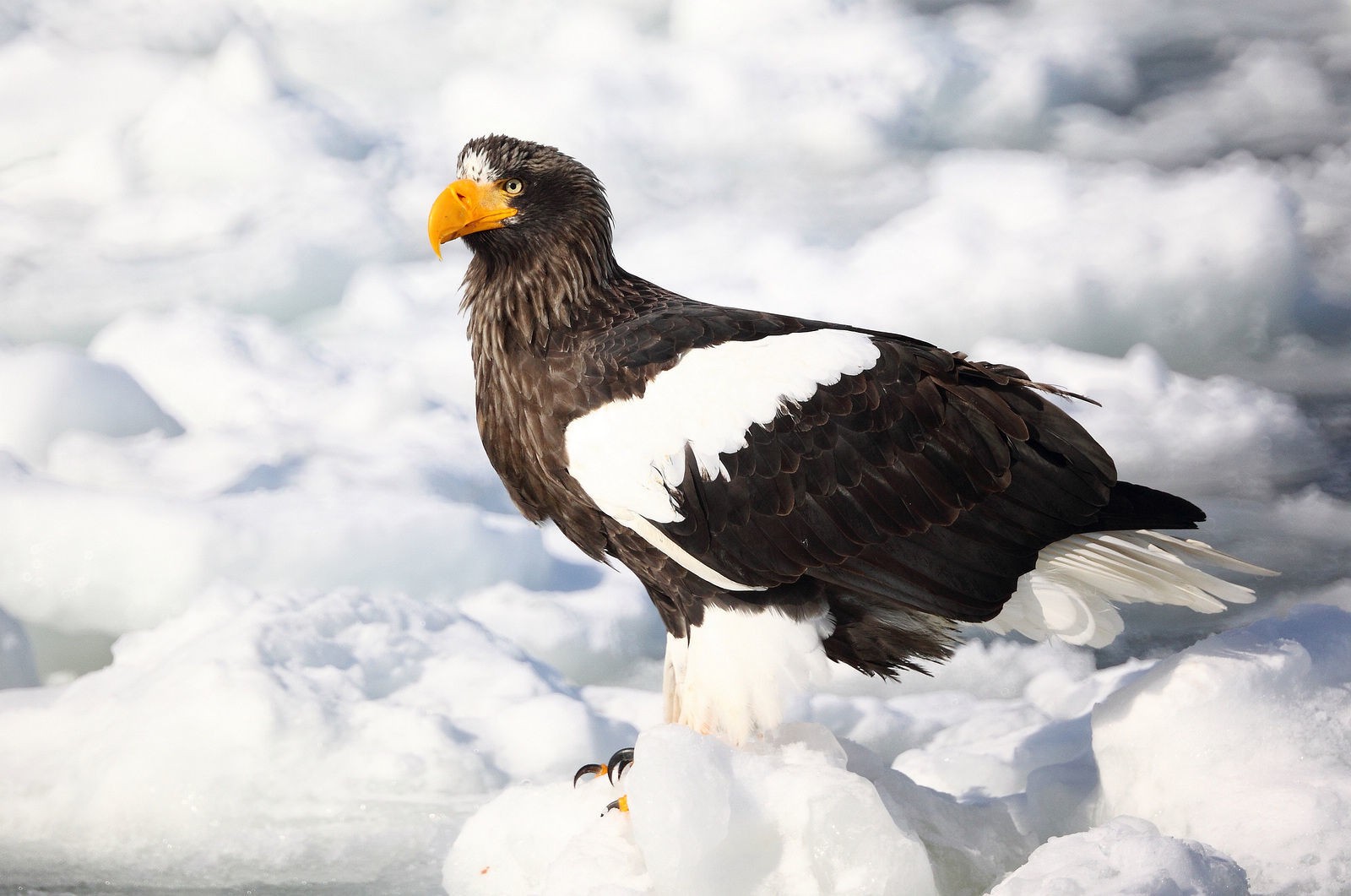Steller's Sea-eagle
A species of Sea eagles Scientific name : Haliaeetus pelagicus Genus : Sea eagles
Steller's Sea-eagle, A species of Sea eagles
Botanical name: Haliaeetus pelagicus
Genus: Sea eagles
Content
Description General Info
 Photo By Sammy Sam , used under CC-BY-SA-3.0 /Cropped and compressed from original
Photo By Sammy Sam , used under CC-BY-SA-3.0 /Cropped and compressed from original Description
Steller's sea eagle (Haliaeetus pelagicus) is a large diurnal bird of prey in the family Accipitridae. It was originally described by Peter Simon Pallas in 1811. No subspecies are recognised. A sturdy eagle, it has dark brown plumage with white wings and tail, and yellow beak and talons. On average, it is the heaviest eagle in the world, at about 5 to 9 kg (11 to 20 lb), but may be below the harpy eagle (Harpia harpyja) and Philippine eagle (Pithecophaga jefferyi) in some standard measurements. It lives in coastal northeastern Asia and mainly preys on fish and water birds. The Kamchatka Peninsula in Far Eastern Russia is known for its relatively large population of these birds. Around 4,000 of these eagles live there. Steller's sea eagle is listed as vulnerable on the International Union for Conservation of Nature (IUCN)'s Red List of Threatened species. 
Size
81 - 183 cm
Life Expectancy
25-30 years
Nest Placement
Cliff
Feeding Habits
Steller's Sea-eagle, a raptor, primarily preys on fish, diving for them or plucking from water. It exhibits opportunistic feeding, also consuming birds, carrion, and mammals. Unique to steller's Sea-eagle are its large, powerful talons, aiding its piscivorous diet.
Habitat
Steller's Sea-eagle's habitat is primarily focused on coastal and riparian zones in Northeast Asia. They inhabit coastal land with forests, river valleys, and areas where rivers meet the sea, which are rich in fish. Steller's Sea-eagle nests are predominantly found in large trees or on high coastal and inland cliffs, adapting to various environments from sea level to 1000 meters. These birds prefer river habitats in autumn for abundant salmon and utilize diverse habitats including sea coasts and lake sides in winter and spring.
Dite type
Piscivorous
General Info
Feeding Habits
Bird food type
Distribution Area
Steller's sea eagle breeds on the Kamchatka Peninsula, the coastal area around the Sea of Okhotsk, the lower reaches of the Amur River and on northern Sakhalin and the Shantar Islands, Russia. The majority of birds winter south of their breeding range, in the southern Kuril Islands, Russia and Hokkaidō, Japan. The Steller's sea eagle is less prone to vagrancy than the white-tailed eagle, as it lacks the long-range dispersal typical of juveniles of that species, but vagrant eagles have been found in North America, at locations including the Pribilof Islands and Kodiak Island, and inland in Asia to as far as Beijing in China and Yakutsk in Russia's Sakha Republic, and south to as far as Taiwan. The large body size (see also Bergmann's rule) and distribution of Steller's sea eagle suggests it is a glacial relict, meaning it evolved in a narrow subarctic zone of the northeasternmost Asian coasts, which shifted its latitude according to ice age cycles, and never occurred anywhere else. Nests are built on large rocky outcroppings or at the tops of large trees on the coast and alongside large rivers with mature trees. Habitat with large Erman's birches (Betula ermanii) and floodplain forests of larches, alders, willows and poplar are preferred. Some eagles, especially those that nest in sea coast, may not migrate. The timing, duration, and extent of migration depends on ice conditions and food availability. On Kamchatka, eagles overwinter in forests and river valleys near the coast, but are irregularly distributed over the peninsula. Most wintering birds there appear to be residential adults. Steller's sea eagles that do migrate fly down to winter in rivers and wetlands in Japan, but will occasionally move to mountainous inland areas as opposed to the sea coast. Each winter, drifting ice on the Sea of Okhotsk drives thousands of eagles south. Ice reaches Hokkaido in late January. Eagle numbers peak in the Nemuro Strait in late February. On Hokkaido, eagles concentrate in coastal areas and on lakes near the coast, along with substantial numbers of white-tailed eagles. Eagles depart between late March and late April, adults typically leaving before immatures. Migrants tend to follow sea coasts and are usually observed flying singly. In groups, migrants are typically observed flying 100–200 m (330–660 ft) apart. On Kamchatka, most migrants are birds in transitional plumages. They are also occasionally seen flying over the northern ocean or perching on sea ice during the winter. 